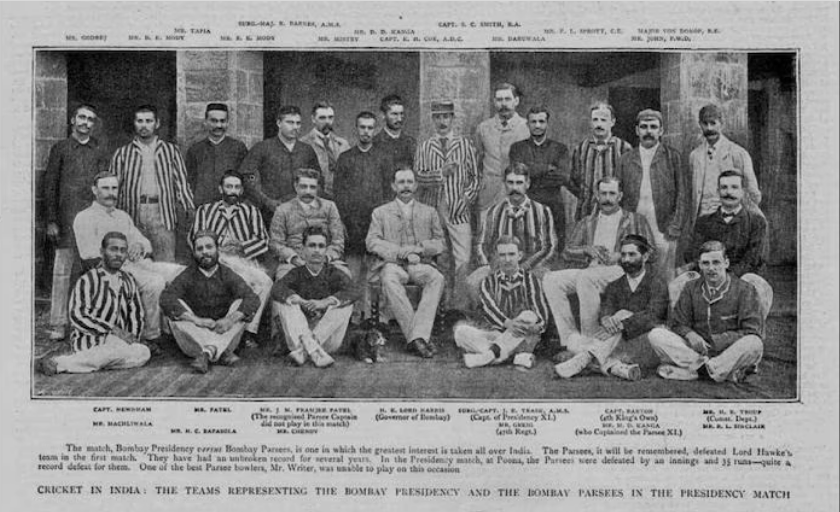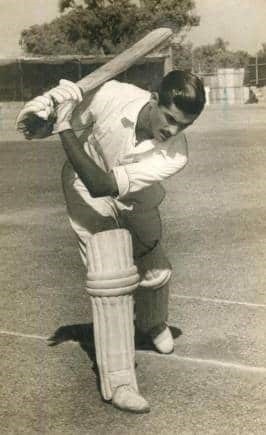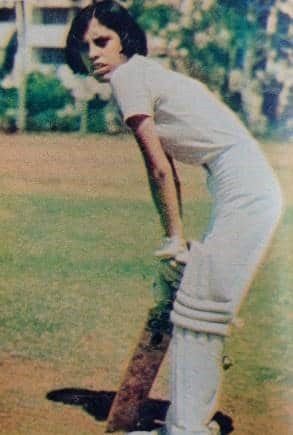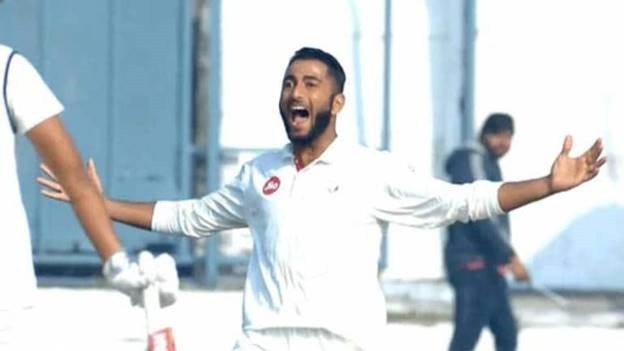The Parsees founded the Oriental Cricket Club in 1848 and the Young Zoroastrian Club in 1850, and as for an opposition to play against, who better than the British themselves?
Article By Abhishek Mukherjee | Money Control
The teams representing the Bombay Presidency and the Bombay Parsees in the Presidency cricket match in 1893. The Parsi Cricket Club organised the first major match in Bombay against the Bombay Gymkhana in 1877, which they lost. (Photo: Mumbai Heritage/Twitter)
The first recorded instance of cricket in India dates back to 1721, but for well over a century, the sport was restricted to the British.
Sometime in the early 19th century, the Parsees of Bombay tried to pick up this curious sport. In the vast maidans of the city, it was not uncommon to see little Parsee boys play cricket, using umbrellas for bats.
The Parsees founded the Oriental Cricket Club in 1848 and the Young Zoroastrian Club in 1850. However, they needed an opposition to play against… and who better than the British themselves?
Thus, the matches began, and the Parsees did well. In 1876, a team of Parsees became the first Indians to beat a British side. The outcome, followed by the jubilation of the fans, did not go down well with the British soldiers, who used their belts on the spectators.
But none of these could dampen the spirit of the Parsees, who kept improving year on year. They sent a team to England, in 1886, then 1888. These were the first two tours by Indian cricket sides to the country.
Related stories
Unfortunately, they quickly found out that cricket in England was vastly superior to anything they had encountered. On the first tour, they won only one match and lost 19. However, they did better next time, winning eight and losing 11.
Despite the results, there were some notable individual performances. In 1886, Shapurjee Bhedwar did the hat-trick against Ashton-under-Lyne. More significantly, in 1888, ME Pavri emerged as the first outstanding Indian cricketer (KS Ranjitsinhji played almost entirely in England).
Bowling at serious pace (the archives record him as “fast”), Pavri finished the 1888 tour with 170 wickets at 12 apiece.
In 1889-90, the first major English side toured India. Of their 13 matches, they lost only once — against, of course, the Parsees, in a match that was hyped as the “Cricket Championship of India”. Pavri took 2-3 and 7-34, and made 21 to help the Parsees chase 77.
Two years later, the Parsees beat another English side, by 109 runs. Pavri claimed 2-18 and 6-36. In 1895, Pavri played in the County Championship for Middlesex.
But before that, in 1892-93, the Parsees, led by Pavri, beat a team called the “Europeans”, which essentially consisted of the British. This much-followed match became an annual rivalry, billed as the Bombay Presidency Match.
Taking a cue, the Hindus joined in 1907-08 and the Muslims in 1912-13, and the contest went from the Bombay Triangular to the Bombay Quadrangular and, with “The Rest” joining in 1937-38, the Bombay Pentangular.
Until it was abolished around the Indian Independence, the Bombay Pentangular remained the most popular cricket tournament in India.
But let us return to the Parsees. As Pavri ruled roost in the 1890s, other stars emerged. Batters “Jessop” Machhliwala and MD Kanga, wicketkeepers RD Cooper and DD Kanga, left-arm seamer Dinshaw Writer, all-rounder Nasarvanji Bapasola were all big names of the era.
But the next truly great Parsee cricketer, HD Kanga (brother of the abovementioned MD and DD), arrived in the early 20th century.
A prominent feature in Bombay cricket, Kanga slammed 233 against the Europeans in 1905. In 1911, he toured England with the first ever All-India side, and made 617 runs at 28.04, including 163 against Leicestershire. In the 1912/13 season, he got 150 against the Muslims and 8-14 against the Europeans in consecutive matches.
When Bombay Cricket Association launched their monsoon cricket league in 1948, they named it after HD Kanga.
As the other communities rose, the Parsees no longer remained the strongest Indian team. Mind you, they were still a formidable force, and two Parsees — Sorabji Colah and Phiroze Palia — played in India’s first-ever Test match, at Lord’s in 1932.
In 1933-34, Rustomji Jamshedji became India’s oldest Test debutant: at 41 years and 27 days, he still holds the record.
In 1944-45, Rusi Modi became the first to score a thousand runs in the history of the Ranji Trophy. For much of that decade, he competed with Vijay Merchant and Vijay Hazare for the title of India’s finest batter.
Polly Umrigar, who arrived in the next decade, held the record for most runs and hundreds by an Indian in Test cricket in the pre-Gavaskar era. He also led India, as did Nari Contractor, the first Indian to score a hundred in each innings on first-class debut.
Nari Contractor
As the 1960s arrived, so did Rusi Surti and Farokh Engineer. For two Test matches on India’s West Indies tour of 1961-62, the two men played alongside Contractor, by then Test captain, and Umrigar — the only instances of four Parsees in the same Test XI.
A brutal injury on that tour ended Contractor’s Test career, while Umrigar retired after the series. But Surti and Engineer continued to play.
A left-arm seamer, left-arm batter, and an electric fielder, Surti continued to play throughout the 1960s. He impressed so much on India’s 1967-68 tour of Australia that Queensland offered him a contract. Surti, thus, became the first Indian to play in the Sheffield Shield.
Khershed Meherhomji and Jenni Irani had kept wicket for India before, but none of them matched Engineer’s stature. An ebullient presence on either side of the stumps, Engineer was the first non Indian outside royal families to play long-term in the County Championship, for Lancashire.
Diana Edulji. (Photo: Twitter)
Unfortunately, Engineer also remains the last Parsee to play for India — among the men, that is. Two seasons after Engineer played a Test match, the Edulji sisters, Behroze and Diana, played in India’s first Women’s Test match, against West Indies in Bangalore in 1976-77.
It remained Behroze’s only Test match, but Diana went on to become a legend. Her 63 Test wickets are the third-most among women and the most for India. She was India’s first captain, led them in two World Cups, and as player, captain, and scout, virtually built the all-conquering Railways domestic side.
Diana Edulji last played for India in 1993. No Parsee has played for India in the three decades since then.
Arzan Nagwaswalla.
Some hope came when India picked Gujarat left-arm seamer Arzan Nagwaswalla as one of the standby cricketers for India’s 2021 World Test Championship final against New Zealand. But Nagwaswalla did not get a Test cap, and has not been in contention for international cricket since.




